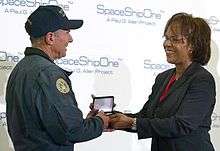Commercial astronaut
A commercial astronaut is a person trained to command, pilot, or serve as a crew member of a privately funded spacecraft. This is distinct from an otherwise non-government astronaut, for example Charlie Walker, who flies while representing a non-government corporation but with funding and/or training coming from government sources.

Criteria
The definition of "astronaut" and the criteria for determining who has achieved human spaceflight vary. The FAI defines spaceflight as any flight over 100 kilometers (62 mi) of altitude. In the United States, professional, military, and commercial astronauts who travel above an altitude of 50 miles (80 km) are eligible to be awarded astronaut wings. Until 2003, professional space travelers were sponsored and trained exclusively by governments, whether by the military or by civilian space agencies. However, with the first sub-orbital flight by the privately funded Scaled Composites Tier One program in 2004, the commercial astronaut category was created.[1] The next commercial program to achieve sub-orbital flight was Virgin Galactic's SpaceShipTwo program in 2018.[2] Criteria for commercial astronaut status in other countries have yet to be made public.
FAA Commercial Astronaut rating
With the advent of private commercial space flight ventures in the U.S., the FAA has been faced with the task of developing a certification process for the pilots of commercial spacecraft. The Commercial Space Launch Act of 1984 established the FAA's Office of Commercial Space Transportation and required companies to obtain a launch license for vehicles, but at the time manned commercial flight - and the licensing of crewmembers - was not considered. The Commercial Space Launch Amendments Act has led to the issuance of draft guidelines by the FAA in February 2005 for the administration of vehicle and crew certifications.[3][4] Currently, the FAA has not issued formal regulatory guidance for the issuance of a Commercial Astronaut Certificate, but as an interim measure, has established the practice of awarding "Commercial Astronaut Wings" to commercial pilots who have demonstrated the requisite proficiency. The content of 14 CFR Part 460 implies that an instrument rating and second-class medical certificate issued within the 12 months prior to the proposed qualifying flight will be included as a minimum standard.
The FAA's Commercial Astronaut Wings Program is designed to recognize flight crewmembers who further the FAA's mission to promote the safety of vehicles designed to carry humans. Astronaut Wings are given to flight crew who have demonstrated a safe flight to and return from space on an FAA/AST licensed mission. To be eligible for FAA Astronaut Wings, nominees have to meet the following criteria and submit an application to the FAA:[5]
- Must be an FAA licensed launch;
- Must meet the requirements for flight crew qualifications and training under Title 14 of the Code of Federal Regulations, Part 460; and
- Must demonstrate flight beyond 50 statute miles above the surface of the Earth as flight crew on an FAA licensed or permitted launch reentry vehicle.
Astronaut Wings
The emblem for the first set of FAA Commercial Astronaut Wings issued in 2004 has in its center a green globe on a blue background, with the three-prong astronaut symbol superimposed on top. In yellow block text around the globe are the words "Commercial Space Transportation" in all capital letters. In a gold ring outside the blue are the words "Department of Transportation Federal Aviation Administration" in black. Beginning with the wings awarded for flights in 2018, the design has been simplified to be the astronaut symbol, surrounded by the words "Commercial Space Transportation", all in gold on a black background.
| Years awarded | Country | Commercial Astronaut Wings |
|---|---|---|
| 2004 | USA |  |
| 2018 - present | USA |  |
List of Commercial Astronauts
| # | Name | Vehicle | Company | Awarding Body | Qualification Date | Max Altitude | Notes |
|---|---|---|---|---|---|---|---|
| 1 | Mike Melvill | SpaceShipOne | Scaled Composites | FAA | 21 June 2004 | 100.124 kilometers (62.214 mi) | First set of Commercial Astronaut wings; flight 15P |
| 2 | Brian Binnie | SpaceShipOne | Scaled Composites | FAA | 4 October 2004 | 112.01 kilometers (69.60 mi) | flight 17P |
| 3 | Mark Stucky | Virgin Galactic Unity | Virgin Galactic | FAA | 13 December 2018 | 82.7 kilometers (51.4 mi) | flight VP-03 |
| 4 | CJ Sturckow | Virgin Galactic Unity | Virgin Galactic | FAA | 13 December 2018 | 82.7 kilometers (51.4 mi) | First to hold both NASA (STS-88) and Commercial Astronaut (flight VP-03) wings |
| 5 | David Mackay | Virgin Galactic Unity | Virgin Galactic | FAA | 22 February 2019 | 89.9 kilometers (55.9 mi) | First person born in Scotland to enter space; flight VF-01 |
| 6 | Michael Masucci | Virgin Galactic Unity | Virgin Galactic | FAA | 22 February 2019 | 89.9 kilometers (55.9 mi) | flight VF-01 |
| 7 | Beth Moses | Virgin Galactic Unity | Virgin Galactic | FAA | 22 February 2019 | 89.9 kilometers (55.9 mi) | First passenger, first woman (Chief Astronaut Instructor and Interiors Program Manager); flight VF-01 |
See also
References
- "SpaceShipOne". National Air and Space Museum. 2016-03-20. Retrieved 2019-06-12.
- Virgin Galactic flies its first astronauts ...
- Commercial Space Flight - New Legislation and the Industry and Developments which Impact Commercial Airports, FAA NW Mountain Region 2005-04-05, accessed 2007-02-20
- "IAC-13-E6.4.5 – INDUSTRY STANDARDS FOR COMMERCIAL SPACE TRANSPORTATION" (PDF).
- Price, Henry J. "Fact Sheet – Commercial Space Transportation Activities". Federal Aviation Administration. Retrieved 22 February 2019.

